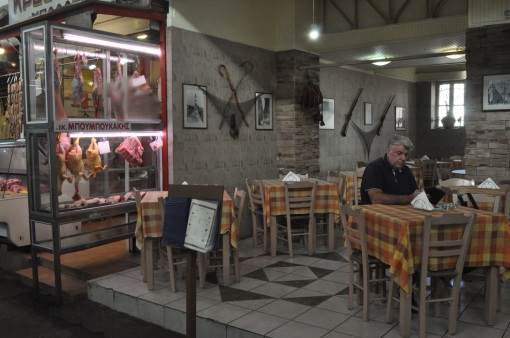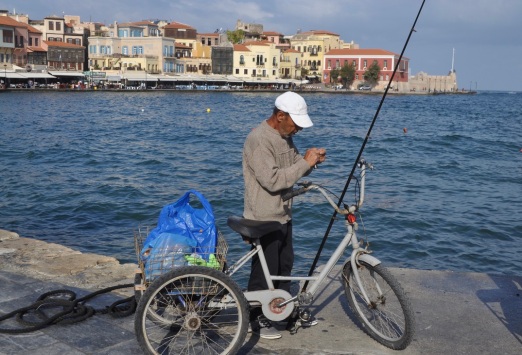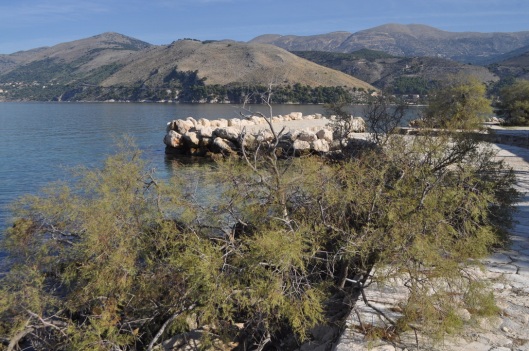After a day and a half at sea, it’s always good to see land. We had docked at Souda, a port city in Chania, a district of Crete, and we were eager to start exploring. I should say right off the bat that this was not our most successful day, part of which was out of our control. The Greek government, in its efforts to provide maximum security for tourists arriving from Israel, made us wait forty-five minutes before allowing the many tour buses – including our two – to leave the port area – meaning no extra time at any of destinations. Plus, Stella, the local guide for our bus, was hardly stellar. But there was another problem that could and should have been avoided. On our last cruise, we were divided by mobility into three groups, each one on a separate bus with a different itinerary. This time, we were all lumped together on bus 1 or bus 2. Some of us were quite fit or reasonably fit, and some, let’s say, weren’t. So, the more fit folks were slowed down by the less fit, and the less fit were made to walk more than was reasonable, given their limitations. Plus, as in many cities, they don’t let buses park where the passengers need to go. Our buses had to park where it was allowed, and then we walked and walked….and walked. First, we went through a quasi-shuk-mall, where we would have liked to stop and browse, but no time. Next, to the port area and the Nautical Museum. I’m certain that anyone with a maritime bent would have found this place of great interest. But I come from a long, distinguished line of landlubbers. To me the best part of the museum was the restrooms.
We then visited Etz Chaim, the one synagogue that still remains on Crete after the Nazis got through with the island. The women who are now running the place are not Jewish; they are part of a mixed group of Christians, Muslims, and a few Jews, who meet Friday evenings for a prayer service in Greek, English, and Hebrew. But they do have five cats in situ, and I was more than happy to make a donation, which might or might not be used to feed the furrier members of the congregation.
We then walked and walked back to the buses, which would take us to a park where we could eat our box lunches and then to the home of Eleftherios Kuyriakou Venielos, considered ‘the maker of modern Greece.’ No doubt, a bigshot in that part of the world; and his house was nice. Did it have the same je ne sais quoi as Chaim Weitzman’s digs in Rehovot? I think not. We didn’t have much time to poke around, see the living quarters or browse through the multi-language library. We had to get back to the ship, scheduled to leave at 3PM. I did have the opportunity to get some interesting photographs, a few of which I’m sharing with you.



If we were pressed for time on Thurs. at Chania, you can imagine what it was like the next day when the Crown Iris docked at Argostoli, the port for Kefalonia. Our ship was scheduled to arrive about 10AM and leave about 4PM. Our group needed to get back even earlier: erev Shabbat, you know. Once again, the Greek authorities were overly helpful. There weren’t that many tour buses going out, but we had to wait until five buses, our two and three others, were ready to go before we could leave the port area.
The main attraction on this large island is Melissani, an underground lake. One might wonder where the water in it comes from. The answer was provided from another question: Where did the water streaming inland from the beach at Katavothres go to? In 1963, some scientists had the bright idea of tracking the water by adding some dye. Sure enough, the water goes backwards, away from the sea inland via underground rivers. Quite unusual, don’t you think?

Our guide, Costa, a vast improvement over Stella, took us first to the beach, where there is a restaurant and what remains of the mills built by the British. Then we took a long bus ride all around the island to Melissani – just in time to meet up with the other tour buses. If we had arrived one bus at a time, there would have been no problem. But we didn’t, and there was. Let’s say you arrive at a destination after being on a bus for an hour, and you need to use the facilities. But so do fifty guys (or gals) ahead of you. And that’s before you can start doing what you’re there for, which is to go down to the underground lake to get on a gondola to ride around for about ten minutes. But now there are over 100 people on line ahead of you, and you’re worried that, by the time it’s your turn, it will be time for the bus to take off, and you’ll miss your once-in-a-life-time opportunity.

No worries. We got our boat ride, with enough extra time to gobble down our lunch and for me to buy a postcard for one of our friends and a magnet for another. What we didn’t have time for was a scheduled stop at the scenic village of Sami, where the movie Captain Corelli’s Mandolin was filmed. At least, as our driver returned us to the port area, we could enjoy the scenery. There in the distance, across the wine-dark sea, was the island of Ithaca, the home base of Odysseus. Nobody in The Odyssey was concerned about getting back in time for Shabbat. Just us.
It must be a difficult job being the Program Director on a Mano cruise – especially when it comes to Shabbat. You’ve got ‘religious’ Jews, ‘traditional’ Jews, and a lot of others who are either secular or not Jewish at all. How do you keep them all happy and in their comfort zones? Not any easy thing to do, but it can be done – with everyone’s cooperation.
There is a beit knesset on deck five, but, like a lot of the facilities on board, it’s a tad too small for the number of people who might use it. It can hold maybe forty guys and a handful of women, not counting the spillover out the door. But it’s Shabbat, so there’s no time for minyan A, followed by minyan B, followed by minyan C. What happened is that minyan A used the shul, and minyan B took over the card-playing room nearby. That’s just for the Sephardim. We – the AACI group as well as any other Ashkenazim on board — prayed in our designated spot, the Seven Seas Lounge. During the normal times of davening the ship was relatively quiet; otherwise, it was business as usual.
The dining rooms? We got to go in fifteen minutes before anyone else and sit at our designated tables, the way we always did. (Some of our group always sat at the same tables with the same people. Barbara and I tried to move around; that way we were able to chit-chat with a lot of our fellow AACI-ers. We all had trouble remembering each other’s names – even with our name tags hung around our necks. Where they live and what their relevant history is – fuggedaboutit.) Because we rate, every dinner, Eli, the ship’s mashgiach and factotum for all Jewish-type stuff, brought around some run-of-the-mill red and white wine for those who wanted. (I’ll pass; life’s too short for plonk.) Shabbat meals we got a downgrade: two of the miniature bottles of kiddush wine on every table in the dining room. What I did was make sure there was somebody else at our table. Wouldn’t you like to make kiddush? That way I wasn’t forced to touch the stuff. (Yuuuuuch!) There were two small challot on every table, with the option of taking more rolls from the buffet, so anybody who wanted could wash and make the appropriate blessing. Otherwise, the ‘menu’ was the usual overabundance –maybe a little more.
Friday night we davened as usual, followed by dinner, followed by an Oneg Shabbat with refreshments (the only way I could get a cup of tea) and a talk by Rabbi Adler. Shabbat morning, we davened Shacharit, then took a break for breakfast (our second meal), followed by Mussaf and a shiur by the Rabbi. A short while later, it was time for lunch (our third meal). Later in the afternoon, there would be Mincha, then more refreshments (A cup of tea, please.) We would then daven Maariv and have a communal Havdala – followed shortly thereafter by the regularly scheduled dinner. I guess you can consider it a melava malcha.) That’s a lot of fressing.
If one is going to observe Shabbat, it’s really important to know when it starts and when it ends. But we were on a ship heading west towards Italy, and sometime Fri. night, we would enter a different time zone, meaning turn the clock back an hour. Could we simply ignore the time change? After all, it would only be for a few days until the ship went back the other way. We could, but the ship wouldn’t (as in when mealtimes would be), so there would be no point.
To make things even more interesting, the next night (motzei Shabbat), we would have to turn our clocks back another hour, this time because everyone was changing from summer time to winter time, which would remain in effect until sometime around Pesach.
There was one other area of confusion. If you were to walk into any synagogue – at least any one I’ve ever heard about – you know which way you’re supposed to face when you pray. There’s never a The shul has turned around since you were last here or a We think Jerusalem has moved since yesterday. But on a ship? Are we still sailing west or are we going north? And on the way back, which way are we going? The only way we could know for sure was to send a scout into the main shul, where they actually had a compass. Once we knew which way we were heading, we could figure out which way was Jerusalem, which is kind of important if your intention is to face that way during davening.
While we were observing Shabbat on the ship, those for whom it was business as usual had the opportunity to explore Bari, an old port city in the south of Italy. We would have to wait until the following evening to disembark, but it was well worth the wait. Our first taste of Italy would be the Pearl of the Adriatic, the magical city of Venice.
Beautiful and very informative.
LikeLike